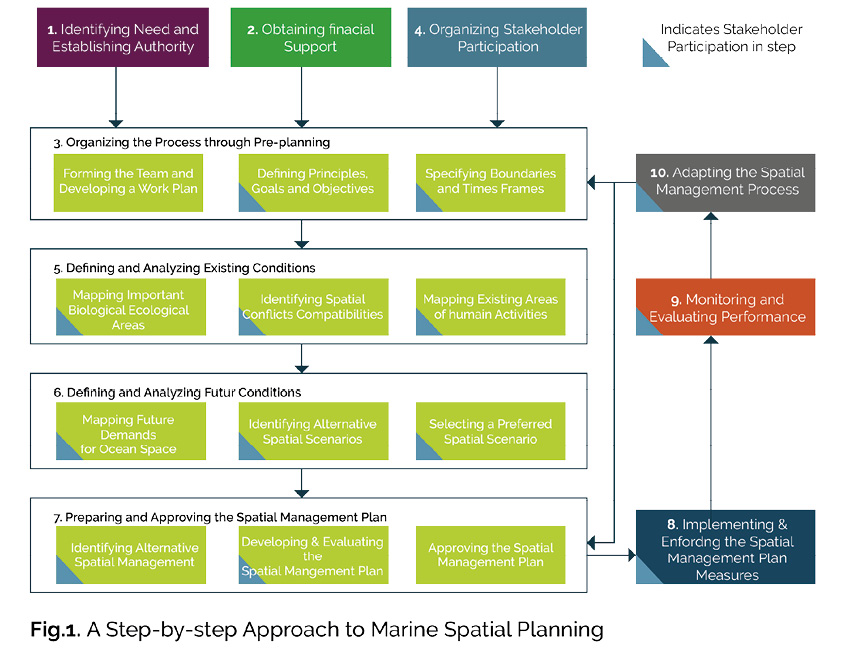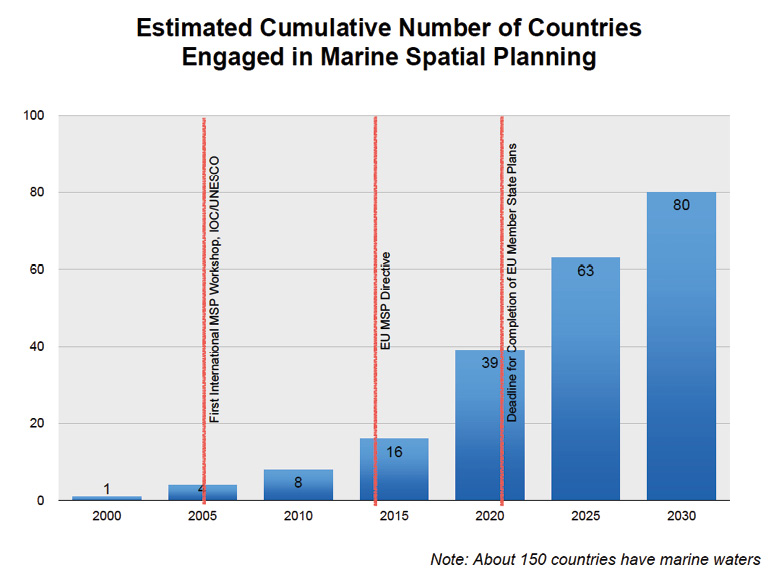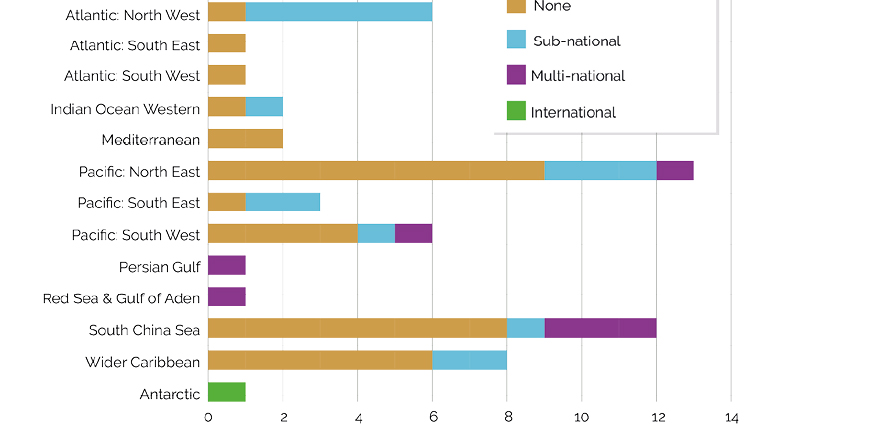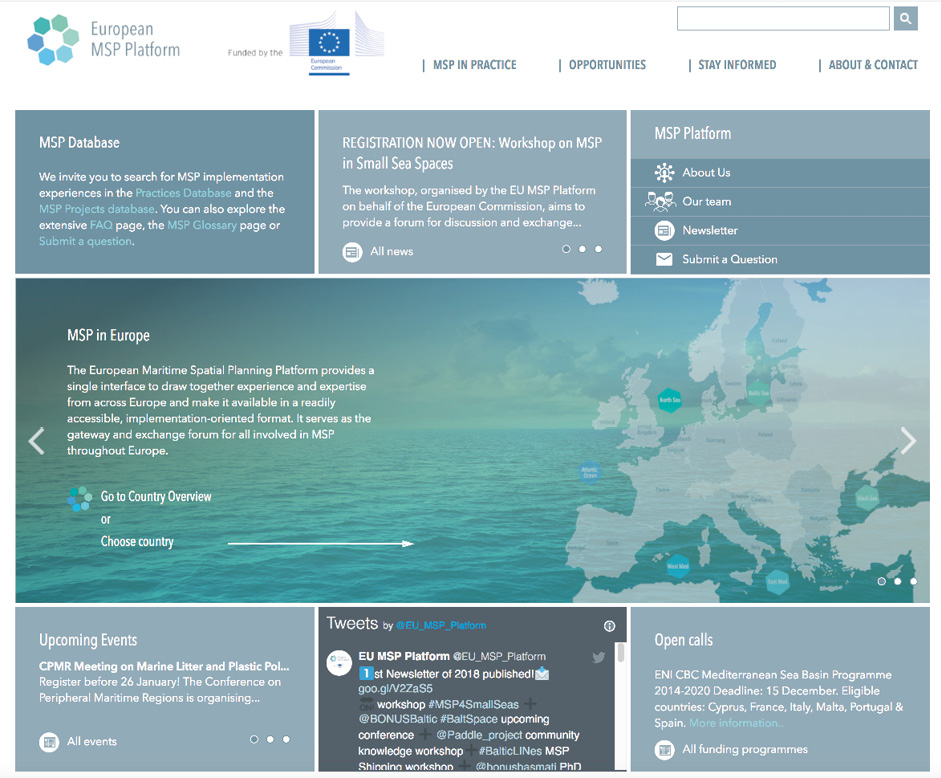1. Introduction
This report presents the content of a web-based toolkit on marine spatial planning (MSP) for Large Marine Ecosystem (LME) practitioners as part of the LME:LEARN project. The MSP toolkit provides MSP practitioners with practical guidance, examples of tools and methods that are necessary for designing and carrying out the MSP process in an LME (Large Marine Ecosystems) context.
In an LME context MSP is still a fairly new concept and most of the ongoing projects and initiatives are the first to start a transboundary MSP. The toolkit draws on existing LME MSP experiences as well as other transnational MSP practices applicable in an LME context to provide guidance to those who intend to or are already involved in an LME MSP initiative.
As part of the larger set of LME toolkits, it shares the aim of promoting an integrated, collaborative approach to coastal and ocean management.
The toolkit is organised according to the general components of an MSP process, and highlights specific aspects which have to be taken into account during a transboundary MSP process. The toolkit provides examples of relevant tools and approaches, which can aid those involved in such a process to implement specific steps in the best possible way.
Numerous handbooks and toolkits exist, which describe the various steps or elements to be included in a given MSP process; with the step-by-step approach developed by IOC/UNESCO (Ehler and Douvere 2009) being among the most commonly known (see example 1.1.1). The steps of this process are used to define the chapters and subchapter of the toolkit, in accordance with the Terms of Reference. Moreover, there are multiple repositories of tools and approaches that provide experiences relevant to transboundary MSP (see examples 1.3.2, 1.3.3).
However, there is no single reference point, which provides quick access to practical information on how to initiate and implement a transboundary MSP process in LMEs. While there are similarities to an MSP process implemented and initiated by one authority within one area of jurisdiction, there are several substantial differences, which need to be taken into account when designing and implementing a transboundary MSP process. This toolkit is therefore designed to highlight the specifics of a transboundary MSP process, especially in LMEs where little MSP experience exists.
1.1.1 EXAMPLE: A step-wise approach to MSP

Figure 1. IOC/UNESCO step-by-step approach to marine spatial planning (Ehler and Douvere 2009)
IOC/UNESCO published a ten-step guide (Figure 1) to implementing an ecosystem-based MSP in 2009. The first part of the guide presents a definition of MSP, its benefits and outputs as well as a description of the relationship between MSP and other marine management approaches. Throughout the text, international examples are presented of MSP at different stages. The steps highlight the actual operationalization of MSP and present a logical order that could be followed to achieve the objectives of a given MSP process. By following the steps, the reader can gain an understanding of the skills and expertise that are needed for developing an MSP plan. The guide describes each of the steps by making reference to specific actions and tasks under that step, and it also presents how the steps may be interrelated in an MSP process. It has been used extensively to promote and guide discussions in the initial stages and designs of MSP processes, as well as in other capacity building efforts – thus, it serves as a relevant foundation for this toolkit.
This toolkit developed for GEF LME:LEARN is partly based on the steps as presented in the IOC UNESCO guide. Even though not presented as steps, the toolkit identifies aspects which require special consideration specific to transboundary MSP for each of the elements of an MSP process. Moreover, it also takes into account the evolution and expansion of knowledge on MSP over the past decade, since the IOC/UNESCO guide has been developed.
►Marine Spatial Planning: a step-by-step approach toward ecosystem-based management
The toolkit provides guidance for those who plan to initiate an MSP process in the LME context, including support for designing, organising and implementing transboundary MSP. It also serves as a signposting platform for supporting individuals who are already involved in transboundary MSP by providing possible tools and methods for one or more specific steps within the MSP process.
LMEs are very diverse with respect to their geographical, ecological, and governance aspects. This diversity, along with differences in the capacity of practitioners as well as marine management approaches globally, is reflected in the toolkit’s “no one size fits all” approach (please see section 2.3). Whereas the general elements of a transboundary MSP process should be more or less generic, the toolkit is not prescriptive. It mainly provides ideas and inspirations for MSP practitioners globally on what has worked elsewhere and whether/how this may also serve as an example for other transboundary MSP processes.
The toolkit is mainly designed to provide guidance for those initiating the very first transboundary MSP process within a given LME. With this in mind, it is important to invest resources in project design to set a good foundation for an initial MSP process, given that MSP is not intended as a ‘one off’ process. Rather, MSP is designed to be adaptable and periodically revisited. The guidance and examples contained in the toolkit may indeed be useful for future ‘turns’ of the MSP cycle, but it is worth noting that the current toolkit places emphasis on designing an initial process (please see Chapter 3).
The toolkit is based on a review of existing studies and repositories of practices from all over the world (see 1.3.1, 1.3.2, and 1.3.3). These ‘Key Resources’ can provide additional information on transboundary MSP and marine management topics which may be of interest to LME practitioners.
Guidance and examples contained in the MSP toolkit are also based on the long-standing experience of consulted experts and the authors themselves in implementing MSP projects. Figure 2 shows that the range of experiences on how to organise an MSP process and prepare a marine spatial plan is rapidly growing throughout the world (Ehler 2017).

Figure 2. Estimated cumulative number of countries engaged in marine spatial planning (Ehler 2017)
However, examples of transboundary MSP processes are still rather limited, especially from outside of Europe, as seen in Figure 3. Moreover, experience in transboundary MSP processes is often less concerned with joint planning, but rather accounts more for experience on how to foster cross-border cooperation and collaboration in MSP across jurisdictions. Furthermore, it has to be underlined that experience in transboundary MSP based on statutory, legal processes established within two countries is even more limited in light of the fact that a very small number of national processes are actively taking place, especially outside of Europe.

Figure 3. Distribution of non-European cross border MSP processes (European Commission 2017b)
Based on this current global state of play, the toolkit takes into account that most transboundary MSP processes within the LME context will mainly start from a situation where a formal MSP authority has yet to be established at the national level. Thus, an initial MSP project for an LME may actually serve as the inspiration for national authorities as well as transnational networks to formally begin an MSP process, as well as incorporate the results and data compiled by the LME MSP project in formal national MSP processes.
1.3.1 KEY RESOURCE: Study “Cross-border cooperation in Maritime Spatial Planning”
The European Commission’s Directorate General for Maritime Affairs and Fisheries (DG MARE) published a study in 2017 on international best practices of cross-border cooperation, with a focus on non-EU examples. The study highlighted lessons learned and good practices from four case studies from across the world. The report also presents recommendations for the international development of MSP. The results of the study can be applied in diverse contexts, with a particular focus on cross-border cooperation. Lessons learned include the notion that a ‘coordinating body or mechanism that is accepted across different jurisdictions facilitates commitment from the relevant parties during planning and implementation’. In addition, ‘creating a sense of collective purpose and trust among authorities involved in the MSP planning process assists collaboration.’
1.3.2 KEY RESOURCE: European MSP Platform

Figure 4: Homepage of the European MSP Platform
The European Maritime Spatial Planning Platform, funded by the European Commission, provides a large repository of practices and relevant information to assist EU Member States in their current processes to develop national maritime spatial plans by 2021. The Platform website (Figure 4) contains databases for Practices and MSP Projects, which includes specific information on European cases of cross-border MSP, such as guidance on conducting cross- border consultation and sea-basin cooperation mechanisms.
1.3.3 KEY RESOURCE: Panorama Marine and Coastal Solutions
The Panorama Solutions platform includes a theme for Coastal and Marine Solutions, curated by the Blue Solutions Initiative. These solutions can illustrate a range of approaches to marine and coastal spatial planning and management, as well as marine protected areas, ecosystem services, climate change and sustainable finance to fisheries, tourism, marine litter or educational and capacity development measures. The solutions can be implemented at different levels (from local to multi-national; from hands-on to policy). The sharing and exchange of these solutions provides others with examples and lessons learned regarding successful approaches that have worked in given contexts. They can inspire others to adapt and replicate these achievements without “reinventing the wheel”, thereby accelerating action for sustaining healthy marine and coastal ecosystems.


























